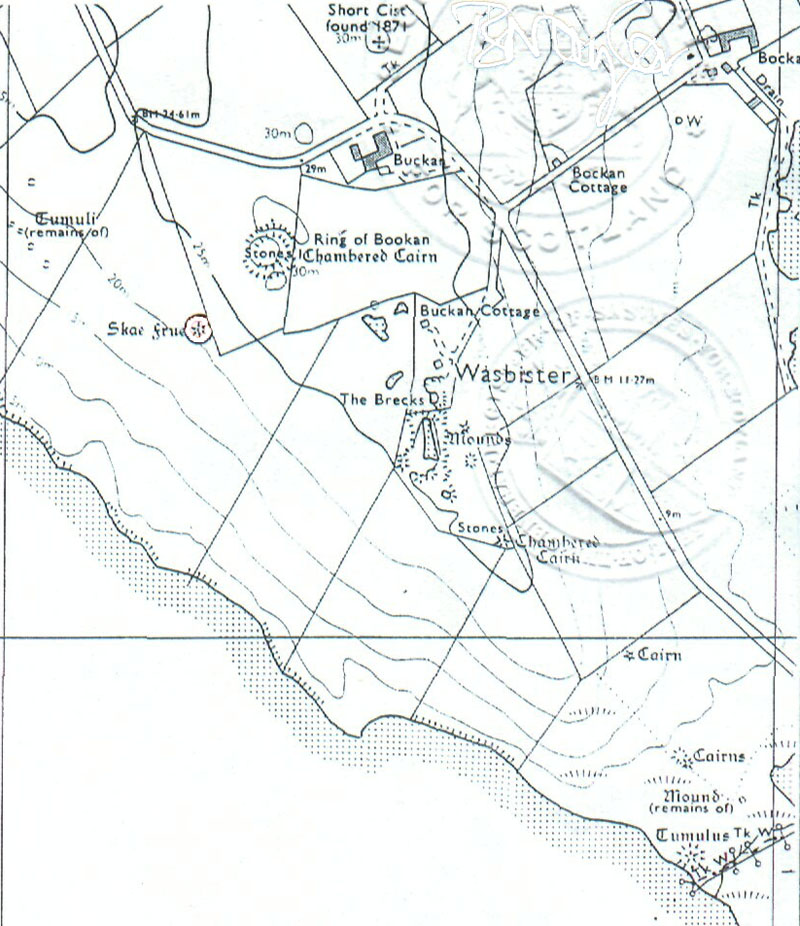
OTHER CODE-BEARING STRUCTURES NEARBY.

The List Of Scheduled Monuments 13-04-10 for Scotland shows these above positions as registered sites. All sit just under half a mile NW of Ring o' Brodgar.
Let's start with three sites shown in the bottom right hand corner of the official map-plan:
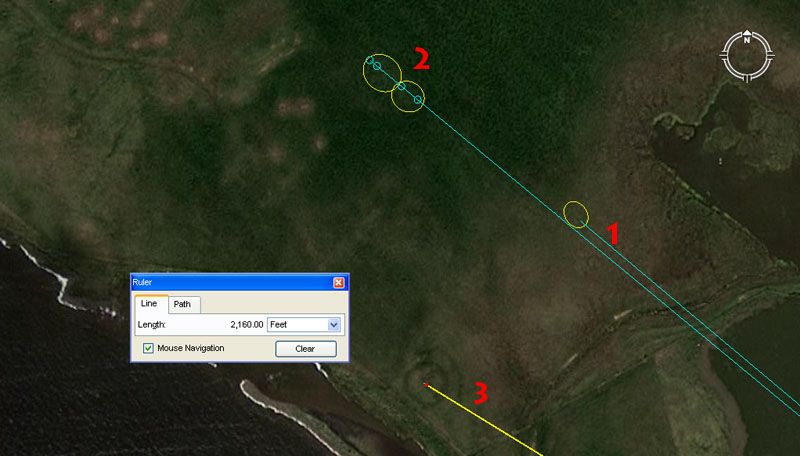
The codes of position are:
1. This cairn seems to sit 2112' out @ 130-degrees return, but the Google Earth image is not sufficiently sharp to clearly detect the structure. Another very close-proximity reading to same position would be 311.04-degrees (equatorial circumference coding) from Ring o' Brodgar.
The sum of 2112' is an fraction expression of the 5280' mile (2112 X 2.5 = 5280).
The 13 progression was important to solar readings in the Sabbatical Calendar, where there were 13 months of 28-days each per month per annum, which was allowed to run like that for 7 solar years before intercalary correction.
2. This is a double set of large cairns that are vaguely detectible. There are several very important distance codes extending through them, including readings of 2400', 2430', 2475' and 2488.32'. The return angle is 129.6-degrees.
The return angle of 129.6-degrees is strong coding related to the Precession of the Equinoxes and the sum of 1296-years would be 1/20th of the cycle of precession. The 1296 value expressions are encoded copiously into the open-air-university sites and the rear of the Heel Stone at Stonehenge sits 129.6' from the centre of the site.
3. This very clearly seen tumulus mound sits 2160' out @ a return angle of 121.5-degrees.
The 2160' distance relates to 2160-years and the Sun, during the cycle of precession, spends 2160-years in each House of the Zodiac. The ancient English Bushel capacity was 2160 cubic inches and the Sumerian/ Babylonian Homer volume was 21600 cubic inches or 10 bushels. The Desert Standard Log (liquid) volume, used by the Hebrews, was 21.6 cubic inches.
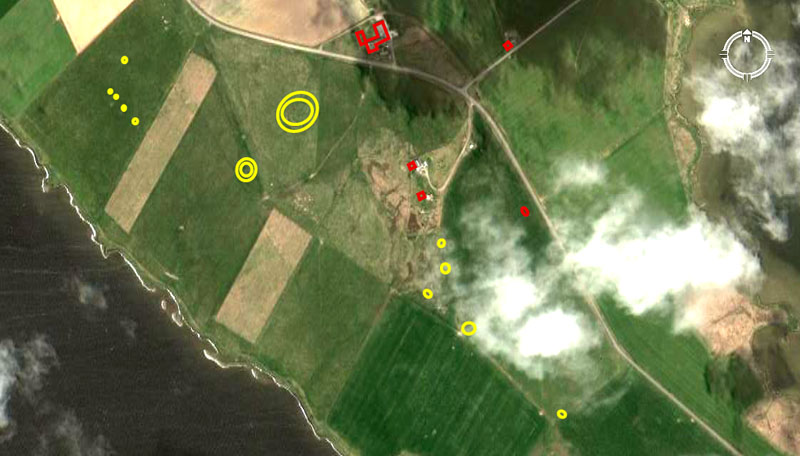
Yellow ovals indicate the positions of yet further cairns and mounds, acting as outer-marker structures and set at coded distances and angles from the centre of Ring o' Brodgar. The most prominent of these is the large Ring o' Bookan chambered mound and Skae Frue ring mound nearby to its SW. The red rectangular objects indicate the positions of buildings, although a lower red oval might be an ancient mound or cairn structure not clearly labeled on the official site plan(?).
Let's extract the codes of position from these:
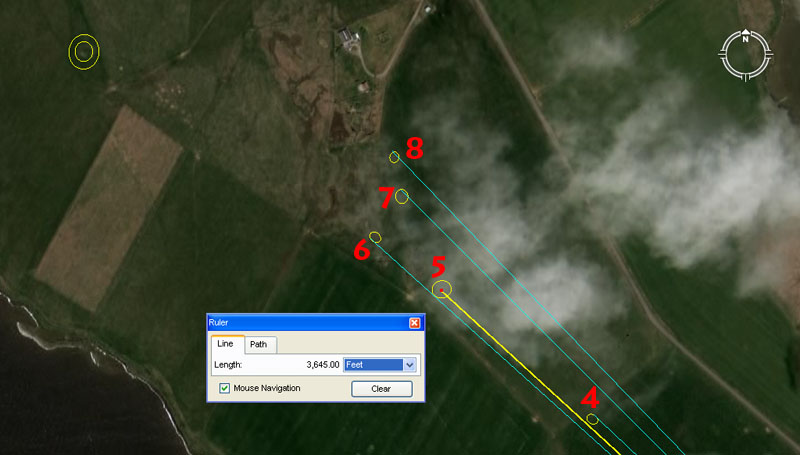
4. This cairn sits 2916' out @ 133.3333-degrees return.
The 2916 value is navigational coding and 2916' is 3000 Roman feet of 11.664" each. The sum of 29.16" would be half a Roman Pace of 58.32" (of course there were no Romans in 3000 BC when these measurements were encoded into the Orkney Islands landscape and the Romans only adopted this system of metrology over 2500-years later.
The degree angle is merely expressing 400 ÷ 3.
5. This cairn sits 3645' out @ 312.5-degrees.
The distance coding is lunar and the sum of 364.5-days would be 1/7th of the 2551.5-days (7.2 lunar years) monitored within the lunisolar Sabbatical Calendar.
The degree angle, when rendered @ 3.125 is a form of the PI ratio used in certain kinds of ancient calculations (e.g.. 24750-miles ÷ 3.125 = 7920-miles ... the diameter of the Earth under the "11" series navigational system). Also, 3.125-miles was an ancient league of 16500'. As stated, this degree angle was what navigators leaving Scapa Flow needed to know in order to hit Iceland.
6. This cairn sits 3960' out @ 132-degrees return.
The sum of 3960-miles is the radius of the Earth.
The sum of 1320' would equate to 1/4th of a mile.
7. This cairn sits 4000' out @ 315-degrees.
The degree angle value, rendered as 3.15, was also a form of PI used in particular kinds of calculations. The sum of 315' was 1/2 a Greek stadia (630').
8. This cairn sits 4125' out @ 136.08-degrees return.
The length of 4125' is 1/4th of an ancient English league (3.125-miles).
The degree angle is coding related to the lunar nutation cycle of 6804-days and 1360.8-days would be 1/5th of that period.
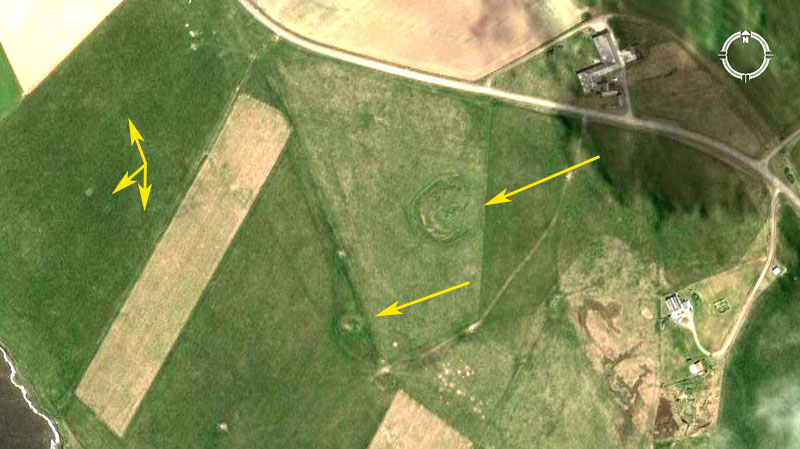
Arrows point to the Bookan Ring chambered cairn and Skae Frue to its SW. The List Of Scheduled Monuments 13-04-10 for Scotland plan also indicates that there are a series of partially wrecked tumuli to the West of these sites, but they show up only very vaguely in this brightened up version of the Google Earth photo.
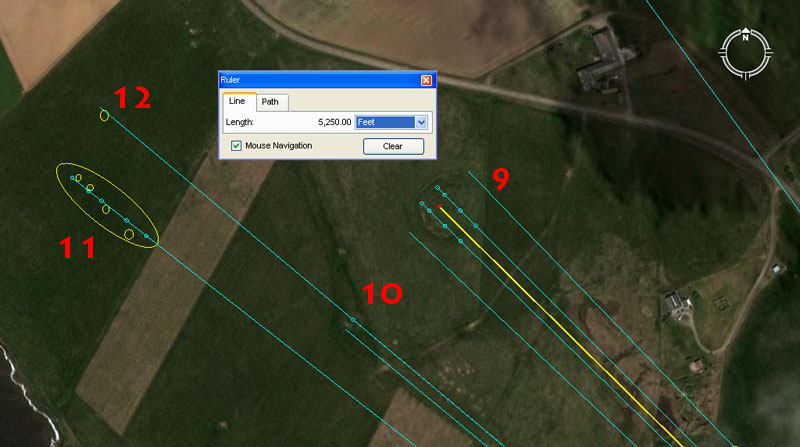
9. Bookan Ring chambered cairn is multi-coded and carries distance and angle codes front & rear, as well as for both ends. The somewhat oval ring sits perpendicular to the central lines extending up from the centre of Ring o' Brodgar, another indication that its orientation was determined by the Ring o' Brodgar's centre. For its due South (perfect South) reading it used the centre dome of Onstan chambered cairn, situated on the southern side of Loch of Stenness 9072 feet away (1.5 minutes of equatorial arc). For its due East reading it used the majestic boulder outcrops at Stany Knowe.
Here are Bookan Ring's readings in relation to Ring o' Brodgar:
(a). The SW side sits 5250' out @ 133.33333-degrees return.
(b) More centrally, positions across the cairn relate to the distances of 5120' (navigation progression), 5184' (multi-use progression) , 5250' (Greek mile) & 5280' (English mile), respectively, @ 314.2857143-degrees (coding the PI ratio X 100, based upon 22/7ths).
(c). All the same distance codes apply as in (b), but the crossing angle is now 315-degrees (315' would be half a Greek stadia).
(d). The NE side sits 5250' out @ a return angle of 136.08-degrees (the 24883.2-mile Earth spins @ 1360.8 MPH).
10. Skae Frue carries at least two sets of codes of position.
(a). To its SW side it sits 5200' (calendar) out @ 130-degrees (calendar) return to Ring o' Brodgar.
(b). More centrally it carries a distance code of 5200' @ 130.68-degrees return (equatorial circumference under the "11" system).
11. Small yellow circles are shown encased by an oval in the left-hand side of the image. The List Of Scheduled Monuments 13-04-10 for Scotland plan gives these as the approximate positions of wrecked tumuli mounds, which seem to lie on a coded angle of 128-degrees return to the Ring o' Brodgar. The codes of distance associated with this set were undoubtedly: 5832', (the Roman pace was 58.32") 5906.25', (59.0625-days would be 2 lunar months) 6000', 6048' (1-minute of equatorial arc) & 6111.11111' (dividing "11" family numbers into ninths), respectively.
12. Again, the approximate position of yet another tumulus is shown. It sits 6180.34' (value based upon the PHI reciprocal) out @ 130-degrees return.
WHILE AWAITING BETTER GOOGLE EARTH IMAGES.
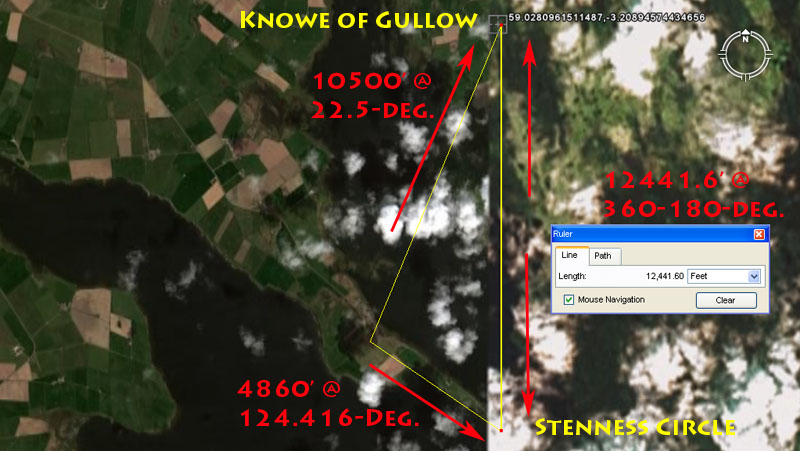
Unfortunately, the presently available Google Earth image does not allow us to directly see some ultra-important sites that reside near the Ring o' Brodgar. These include Maeshowe and the Stenness Circle, as well as the Watch Stone, the known position of the Odin Stone, etc., all of which are utterly obscured by a low resolution fog. Added to that impediment is the fact that official coordinates supplied by RCAHMS are often insufficiently accurate for our purposes here, as we need to know the exact epicentre of a site like Maeshowe.
The positions of sites lost in the fog can be determined very adequately by triangulation from other clearly seen sites, but nothing replaces being able to visually detect and positively identify a site within the Google Earth image. With the foregoing in mind, here are a couple of preliminary assessments related to what's going on between the Stenness Circle and Knowe of Gullow Mound to its North. When clear images are available we can recheck these results.
Navigation students working from Stenness Circle seemingly used the Knowe of Gullow Broch mound as the fix for true North. Similarly, student navigators at Gullow mound could use the Stenness circle to get a perfect fix on due South.
1. The coded distance from Brodgar's centre to Gullow Broch mound appears to have been 10500' or two so-called Greek miles of 5250' @ 22.5-degrees (1/16th of 360-degrees).
2. The coded distance from Ring o' Brodgar to the Stenness Circle appears to have been 4860' (1 so-called Roman mile) @ 124.416-deg (coding related to the value used for half the world's equatorial circumference @ 12441.6-miles)..
3. The coded distance from Stenness Circle to Gullow Broch is 12441.6' (equatorial circumference again) @ 360-degrees (due North).
SOME MORE PRELIMINARY ASSUMPTIONS THAT INCLUDE MAESHOWE.
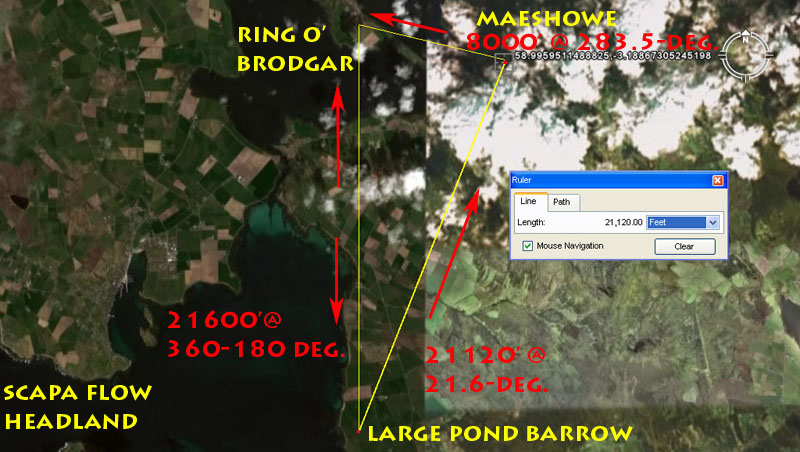
Sitting 21600' due South (180-degrees) of the centre of Ring o' Brodgar is a large circular depression in the ground that seasonally traps water to form a pond. It is located at Clestrain-Upper Sower and was probably (once) a purpose-built pond barrow to mark due South from the centre of Ring o' Brodgar.
From the (theoretical) pond-barrow the line runs to Maeshowe chambered cairn 21120' distant (4 English miles) @ 21.6-degrees. From Maeshowe to Ring o' Brodgar's centre is 8000' @ 283.5-degrees (lunar coding ... The Khafre Pyramid was 2835' for 1 circumnavigation of all 4-sides).
There are 21600-minutes of arc in the circumference of the world (6048' X 21600 = 130636800 .... 24883.2-Greek miles of 5250' ea.) or (6050' X 21600 = 130680000 ... 24750-miles of 5280' ea.). The distance is 21600' to the southern side of the pond barrow or 21504' (3.2 Irish miles of 6720') to the northern side. There are 19440 Irish miles in the 24883.2-Greek mile circumference or 26880 Roman miles of 4860'.
The ancient English Bushel was 2160 cubic inches. The Sumerian/ Babylonian Homer volume was 21600 cubic inches or 10 English bushels. The sun spends 2160-years in each of the twelve Houses of the Zodiac during the 25920-year cycle of the Precession of the Equinoxes.
The 21120' = 4-miles of 5280', from the SSW side of the mound to Maeshowe. The pond barrow is, however, 120' wide and so the distance from the NNE side to Maeshowe is 21000' or 4-miles of 5250'.
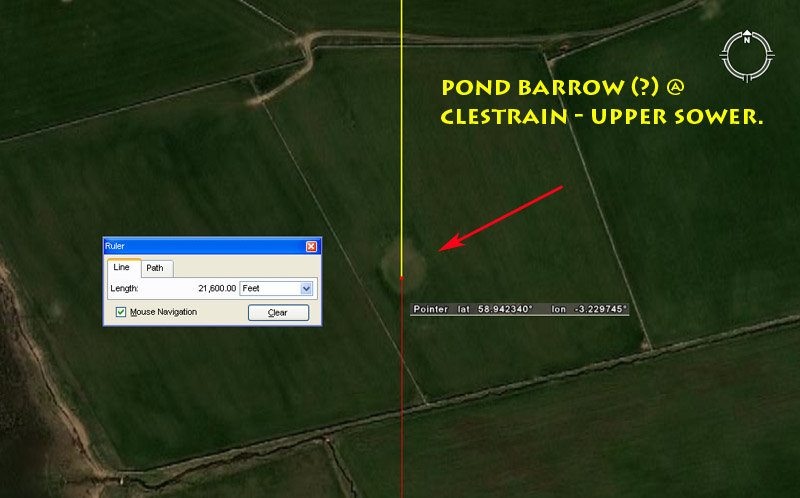
Could this just have happened by chance, that a large, circular depression sits perfectly due South of the Ring o' Brodgar @ 21600' and perfectly due East of the centre of the Graemsay- Stromness headlands entry into Scapa Flow?
Pond Barrows are found throughout Britain at lower latitudes than the Orkney Islands, but are oftimes hard to identify as a purpose-built archaeological feature. They can appear to be nothing more than a natural dish or depression in the ground, unless they display a very visible outer ring bank. In many instances it has been possible to associate the pond barrows with cremations, as charcoal from funeral pyres, burnt bones or urns containing human ashes have often been found buried around the perimeter or within the pond barrow depressions. Another feature of the pond barrows is that they might only flood seasonally to become a temporary pond, reverting to a dry dish in the ground in the drier seasons. This is the case with the large, circular ground depression near Clestrain. The site has gone unrecognised as a pond barrow and does not feature in the list of registered monuments identified by Historic Scotland. What additional compelling clues do we have, however, to strongly suggest that this is, in fact a purpose-built pond barrow?
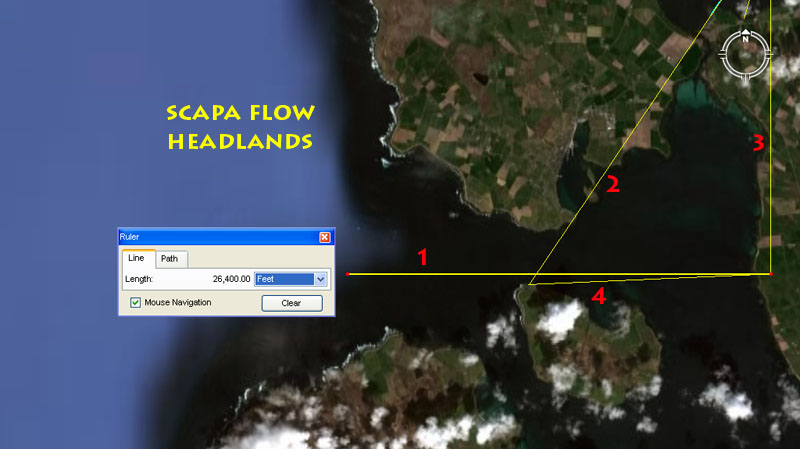
1. The pond barrow depression sits due East of the Scapa Flow headlands and is, itself, situated just above sea level. From this vantage point the Sun, at the vernal & autumn equinoxes, will be seen to set in the trough between the Graemsay- Stromness headlands (due West), then merge into Stromness headland and disappear. This bi-annual occurrence gives a very refined fix relative to the exact day of the equinox and the pond barrow position would have, most-definitely, functioned perfectly as a solar observatory.
If future excavations at this site reveal evidence of cremations, then there is probably a religious or ritual dimension associated with the "pond barrow's" position also. In ancient, traditional Caucasoid-European belief systems the Sun was the vicarious representation of God and, at the time of death, an individual's soul went "West" or to the place of the setting Sun. Similarly, ships leaving a harbour would first turn Sun-wise before proceeding on their journey, in honour of and to pay homage to the Sun-God. Those being married would dance or circle Sun-wise as a part of their ceremony, in order to invite the Sun-God's blessing upon their union.
In a more down-to-Earth or practical sense the visible glow from funeral pyres, on occasions, at the pond barrow site (if it was ever used in that capacity) would act as a due East beacon to ships arriving at the headlands in hours of darkness, making the position act very much like a pseudo-"lighthouse" on occasions.
2. Yet another code-bearing triangle is formed relative to the positions of Ring o' Brodgar's centre, coupled with the edge of the Scapa Flow headland near Point of Oxan lighthouse, then across to the "pond barrow" situated due South of Ring o' Brodgar.
The distance to the southern headland extremity, from Ring o'
Brodgar, would have been read as 26880' @ 34.02-degrees return. This distance
is 4 ancient Irish miles of 6720' each or 1/4860th*
of the equatorial circumference of the Earth.
Footnote: The ancient Roman mile was 4860' or 5000 Roman feet
of 11.664".
The return angle to Ring o' Brodgar is strong lunar coding, also associated with Unstan chambered cairn and this line traverses that site's position.
3. The distance from Ring o' Brodgar to the southern side of the "pond barrow" is 21600'.
4. The distance from the "pond barrow" centre to the extremity of the Point of Oxan shoreline would have been coded to read 15120' (2.5 minutes of equatorial arc) @ 87.5-degrees (navigational & lunar coding) return to the "pond barrow".
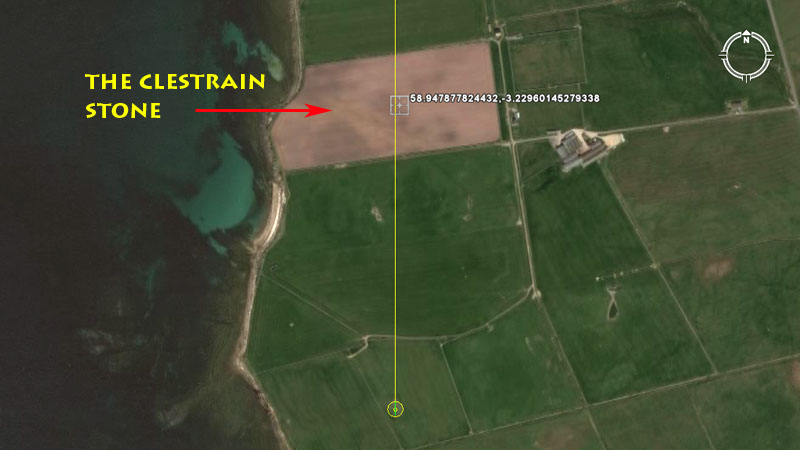
Regardless of whether or not a future archaeological investigation establishes that a pond barrow was situated at Clestrain, a 7' 9" standing stone (now moved) is known to have sat on or very close to the line marking due South from Ring o' Brodgar. The RCAHMS (The Royal Commission on the Ancient and Historical Monuments of Scotland) gives the above position as the upper range of the original standing position, but estimates it could have been slightly further South.
In consideration of the kind of surveying-related coding one would expect to find in a position such as this, a dynamic, close-proximity value would be 19687.5' due South from Ring o' Brodgar's centre or about another 120' further South of the RCAHMS estimate for the Clestrain standing stone (now lying beside a field wall near the Hall of Clestrain). See: http://canmore.rcahms.gov.uk/en/site/1514/details/hall+of+clestran/
1. The sum of 19687.5' would equate to 3.75 Greek miles (of 5250' each).
2. It is highly probable that this very refined observation position (the width of a single stone) was where one stood to view the Equinox sunset at the headlands between Graemsay and Stromness. The position was, undoubtedly, the pre-eminent solar observatory for the immediate vicinity, ranging to the standing stones of Stenness. There would have been some very exploitable attribute about the position, sufficient to place the stone at that exact spot ... like how the Sun set into a trough made up of the sea horizon conjunction with the Stromness headland?
HALL OF IRELAND, STENNESS.
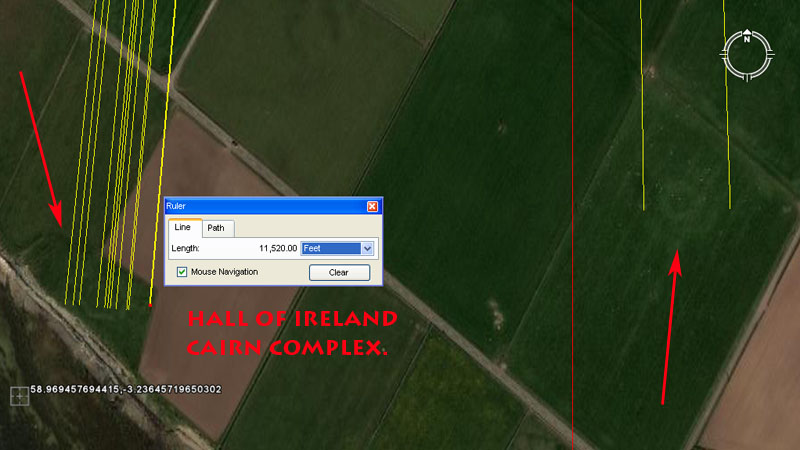
The Hall of Ireland cairn (left) is enshrouded in multiple coded vectors in the above picture, but remains semi-visible. It sits 11520' (coding for the equatorial circumference of the Earth) from Ring o' Brodgar and the return angle vectors sweeping across the site range from 5-degrees to 5.76-degrees, with all being highly important to ancient calculations within cyclic astronomy or navigation. The large cairn to the right sits 11250' (360-degree compass coding) from Ring o' Brodgar and is bracketed by two important angle vectors, 178.2-degrees (navigation) & 179.2-degrees (navigation & lunar), respectively. A red line is seen to be traversing the site due South of the Ring o' Brodgar, dissecting several purpose-built ancient surveying structures en route.
IN LIEU OF MAESHOWE WE'LL SUBSTITUTE IN SKARA BRAE INSTEAD.
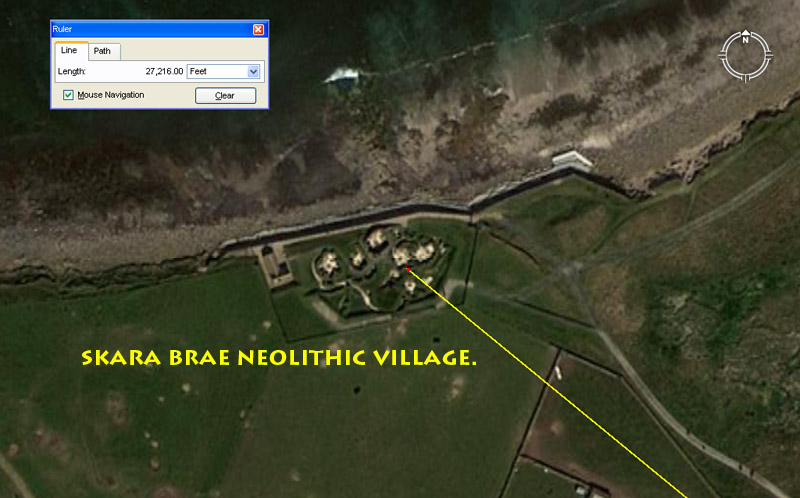
Amongst the most impressive sites of the Orkney Islands is the so-called Neolithic village of Skara Brae, which might have managed to house about 50 people comfortably. Again, it has all of the attributes of a hostel, offering about 25 stalls for sleeping accommodation overall, 12 of which are in the 76' long main chamber. This large structure was, undoubtedly, an assembly area for combined groups of student navigators returning from or venturing out on their various circuit assignments.
A yellow vector, originating at the centre of Ring o' Brodgar is seen to resolve in the heart of Skara Brae Neolithic Village. The distance from Brodgar is 27216' @ 309.375-degrees (3093/8ths).
1. This length is 5.184 Greek miles of 5250' each and the distance is 1/4800th of the 24883.2 Greek mile equatorial circumference of the Earth.
2. The length of 27216' is 4.5 minutes of equatorial arc, based upon 6048' per minute (the literal coding found in the base dimensions of the Great Pyramid ... which, incidentally has a slope angle of 51.84-degrees and covers an area of 5184 square reeds of 10.5' each). The sum of 27216-days would be 4 X the 6804-day duration of the lunar nutation cycle.
3. Were the length permitted to run for an additional 9', then the second navigational system (the "11" system using a mile of 5280') would come into play. This slightly elongated line would resolve in the centre width of Skara Brae.
4. The angle of 309.375-degrees is also navigational coding under the "11" system and the sum of 3093.75-miles of 5280' each would be 1/8th of the 24750-mile equatorial circumference.
SOME ATTRIBUTES OF "BROCHS"& THEIR RELATIONSHIPS TO RING O' BRODGAR.
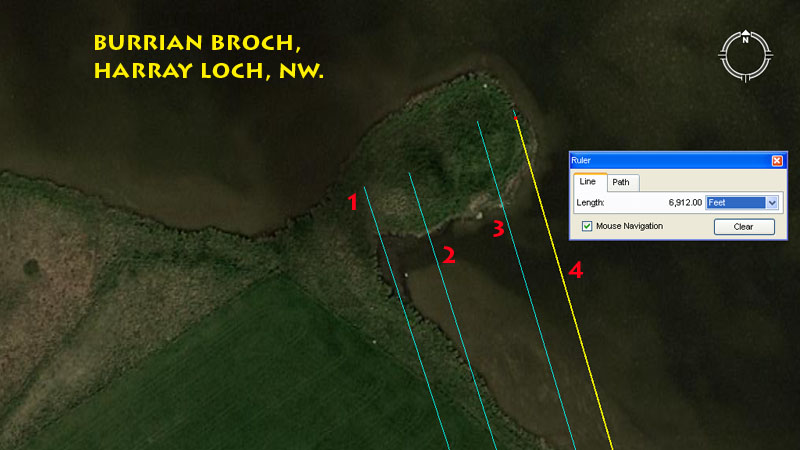
In the same modus operandi as one finds at Unstan chambered cairn, vectors from the centre of Ring o' Brodgar bracket the Burrian Broch complex, which is situated on the NW shores of Loch Harray. It will be noted that there is a "V" trench through the broch that orientates directly towards the centre of Ring o' Brodgar.
Here are the codes-of-position for this purpose-built site:
1. 6875' @ 162-degrees.
The sum of 68.75-miles was 1-degree of equatorial arc under the 24750-mile ("11"-family) navigational method.
The 162 value represented "rounded PHI" (1.6180339 rounded to 1.62). Mathematical progressions based upon this value provide a raft of highly useful numbers used in all manner of ancient calculations (lunar, navigational, etc.)
2. 6875' @ 162.5-degrees.
The 162.5 value is a part of a progression used in calendar calculations.
3. 6912' @ 163.35-degrees.
The sum of 69.12-miles would be 1-degree of arc for a world configured to be 24883.2-miles in circumference (12 X 12 X 12 X 12 X 1.2).
The sum of 16335' would be 1/8000th of the 24750-mile equatorial circumference.
4. 6912' @ 343.75-degrees.
The sum of 34.375-miles would be 1/2 of 1-degree of arc in a world configured to be 24750-miles in circumference.
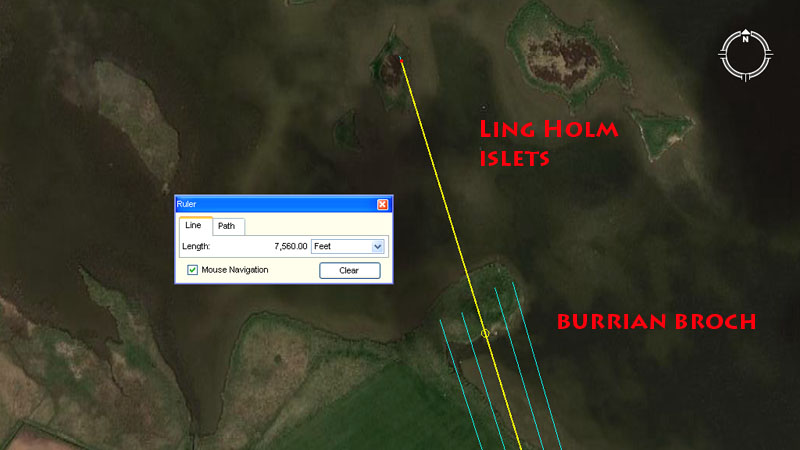
A line is seen to traverse through the centre of Burrian Broch's "V" trench and resolve upon one of the Ling Holm islets. This distance is 7560', or 1.25 minutes of equatorial arc. Where the line touches Burrian Broch's southern side, the distance covered from Ring o' Brodgar is 6804' (coding the lunar nutation cycle).
ACROSS THE LOCH.
There's another "Burrian Broch" situated to the NE across the Harray Loch.
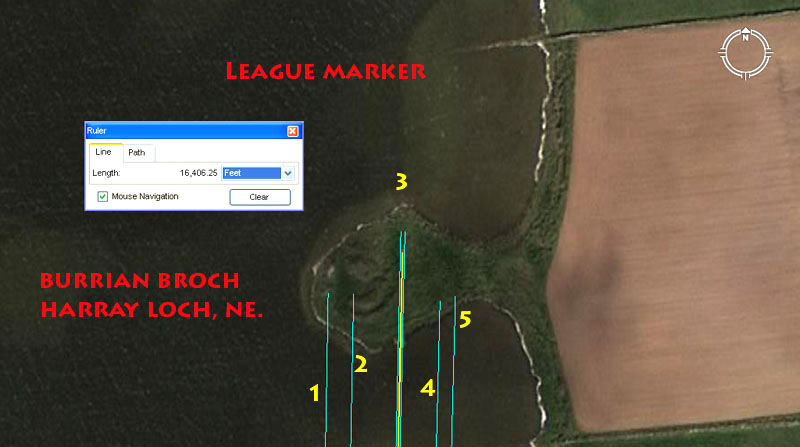
This other "Burrian Broch" displays the same design attributes as its counterpart across the loch to the SW, including a central sighting trench that orientates directly towards Ring o' Brodgar.
The bracketing vectors of this brock range from .8 of a degree to 1-degree. The central trough or ditch sits 1 Greek league or 16406.25' (based upon the usual formula of a league being 3.125-miles) out from Ring o' Brodgar's centre.
The main distance code to fall upon the broch from Ring o' Brodgar was 16335', which would equate to 1/8000th of the 24750-mile equatorial circumference.
One can readily see why these latter-era "brochs" were carefully positioned to sit precisely over the top of earlier, simpler, surveying marker structures like chambered cairns or mounds.